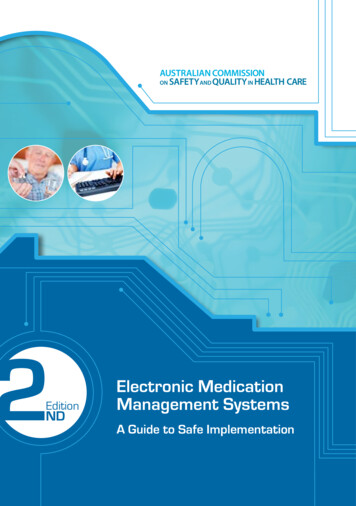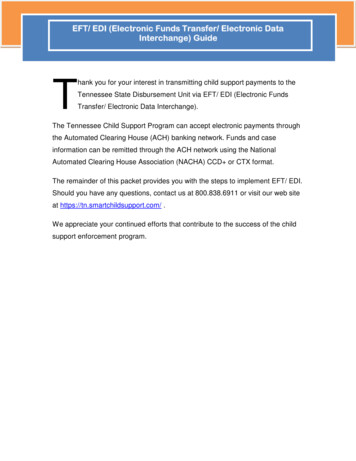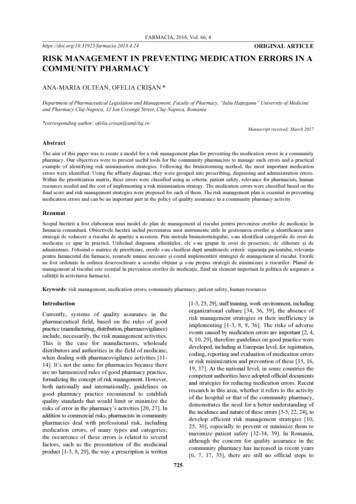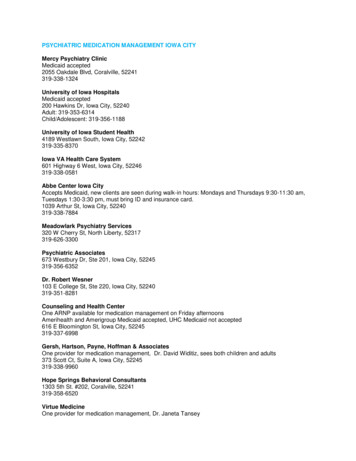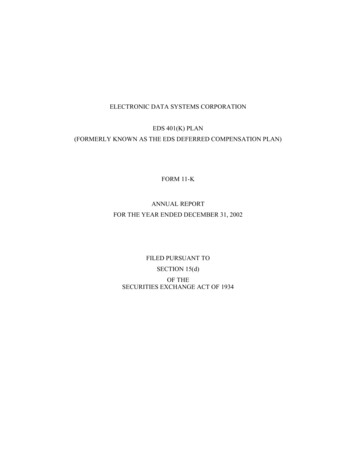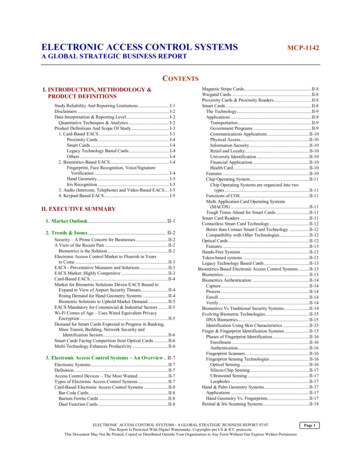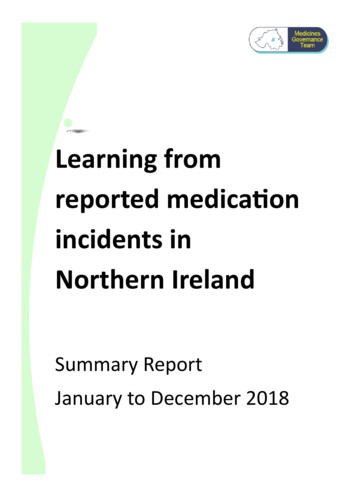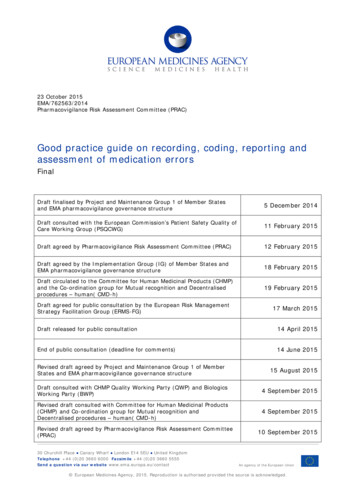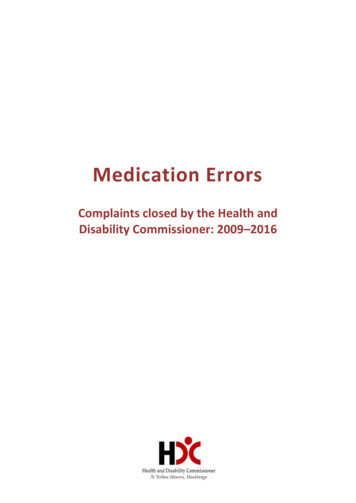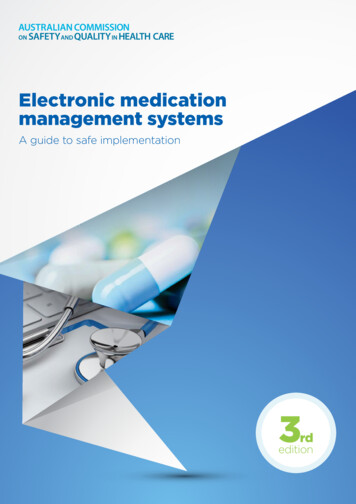
Transcription
Electronic medicationmanagement systemsA guide to safe implementation3rdedition
Published by the Australian Commission on Safety and Quality in Health CareLevel 5, 255 Elizabeth Street, Sydney NSW 2001Phone: (02) 9126 3600Fax: (02) 9126 3613Email: support@accreditation.freshdesk.comWebsite: www.safetyandquality.gov.auISBN: 978-1-925665-06-2 Australian Commission on Safety and Quality in Health Care 2017All material and work produced by the Australian Commission on Safety and Quality in Health Care isprotected by copyright. The Commission reserves the right to set out the terms and conditions for the useof such material.As far as practicable, material for which the copyright is owned by a third party will be clearly labelled.The Australian Commission on Safety and Quality in Health Care has made all reasonable efforts to ensurethat this material has been reproduced in this publication with the full consent of the copyright owners.With the exception of any material protected by a trademark, any content provided by third parties,and where otherwise noted, all material presented in this publication is licensed under a Creative CommonsAttribution-NonCommercial-NoDerivatives 4.0 International Licence.Enquiries regarding the licence and any use of this publication are welcome and can be sent tocommunications@safetyandquality.gov.au.The Commission’s preference is that you attribute this publication (and any material sourced from it) usingthe following citation: Australian Commission on Safety and Quality in Health Care. Electronic medication management systems:a guide to safe implementation. 3rd edition. Sydney: ACSQHC; 2017.DisclaimerThe content of this document is published in good faith by the Commission for information purposes.The document is not intended to provide guidance on particular healthcare choices. You should contactyour healthcare provider on particular healthcare choices.This document includes the views or recommendations of its authors and third parties. Publication of thisdocument by the Commission does not necessarily reflect the views of the Commission, or indicate acommitment to a particular course of action. The Commission does not accept any legal liability for any injury,loss or damage incurred by the use of, or reliance on, this document.
ContentsPreface 6Acronyms and abbreviations 1.7Overview 81.1Purpose 81.2Scope 81.3Additions 92. How to use the guide 2.110EMM in the Australian context 11Part AEMM context, standardsand technology 123.14Case for change 4. Essential elements ofan EMM implementation 165. Medication managementcontinuum 185.1Medication management process 196. EMM strategic, medicationand functional scope 226.1Strategic context 236.2Medication scope 276.3Functional scope 307. How EMM supports nationalmedication safety priorities 7.134Quality use of medicines 347.2 M edication reconciliation, includingbest possible medication histories 7.3High-risk medicines 357.4 Preventing and controllinghealthcare‑associated infections 7.53435Patient identification 377.6 O pportunities to support other safetyand quality standards 8. EMM national infrastructureand standards 37388.1My Health Record system 388.2Healthcare Identifiers Service 398.3National Clinical Terminology Service 408.4Digital supply chain solutions 418.5 Secure messaging and clinicalexchange specifications 428.6 O n-screen display of clinicalmedicines information 428.7 O n-screen display ofdischarge summaries 448.8Prescription exchange services 459. Business requirementsfor EMM systems 469.1Introduction to the Requirements 469.2How to use the Requirements 47Electronic medication management systems – A guide to safe implementation3rdedition1
ContentsPart BEMM organisationalconsiderations 4810. Principal EMM stakeholdersand users 5010.1 Principal stakeholders anddecision-makers 5010.2 Clinicians using EMM 11. EMM project governance 556011.1 Project sponsor 6211.2 Project board 6211.3 Project manager 6211.4 Project team 6311.5 Reference group andspecialty subgroups 6411.6 Project management 6412. Organisational changemanagement 68Part CEMM implementation project 7413. EMM systemimplementation process 7614. Stage 1 – project initiation 7814.1 Developing the EMM business case 7814.2 Obtaining funding approval 8114.3 Procurement, product evaluationand selection 8214.4 Contract management 9515. Stage 2 –implementation planning 9615.1 Learning the lessons ofAustralian implementations 9615.2 Considering the literature 9915.3 Implementation planning study 10515.4 Implementation scope 10810912.1 Stakeholder assessment 6915.5 B usiness process mappingand redesign 12.2 Targeted engagement strategies 7015.6 Policy development 11312.3 Change readiness assessments 7115.7 Implementation sequence planning 11512.4 Addressing stakeholder concerns 7215.8 Evaluation planning 11612.5 Identifying champions andchange agents 15.9 Benefits management planning 1217215.10 Education and training 12415.11 Project communications 12715.12 Quality management 12816. Stage 3 – EMM systembuild and configuration 13016.1 Acquiring technical infrastructure 13016.2 Software development 13016.3 Building the technical environments 13116.4 Non-functional testing 13116.5 Configuration of EMM system content 1322Australian Commission on Safety and Quality in Health Care16.6 D eveloping interfaces withthird‑party systems 13216.7 User acceptance testing 13316.8 Ensuring business continuity 135
17. Stage 4 – implementationand go-live activities 13617.1 Implementation checklist 13617.2 Project control centre 13817.3 Go-live roles and responsibilities 13817.4 Tasks before and after go-live 13817.5 Escalation strategy 13817.6 M anaging the transition in astaged implementation 13922. Monitoring and evaluation 15622.1 Benefits measurement 15622.2 O ptimising EMM workflow andmedication safety 15623. Continuous quality improvementand data analytics 15823.1 Continuous quality improvement 15823.2 Data analytics 16017.7 Rollback 139Glossary 16217.8 Project team exit strategy andtransition to support References 16313918. Stage 5 –post-implementation review 14019. Business continuity planning 142Part DEMM post-implementation 14420. Operationalising theEMM system 14620.1 Governance 14620.2 Resourcing 14720.3 EMM configuration and maintenance 14720.4 EMM software upgrades 14820.5 Education and training 14820.6 EMM solution provider support 14920.7 Rehearsing and refining businesscontinuity plans 14921. Regulation, policyand compliance 15021.1 Regulation 15021.2 Policy 15221.3 Compliance 155Electronic medication management systems – A guide to safe implementation3rdedition3
ContentsTables4Table 1.1Stakeholders and relevant sections of this guide to read 11Table 6.1Example of a strategic scope analysis 26Table 6.2Example of a medication scope analysis 28Table 6.3Example of a functional scope analysis 31Table 12.1Example of a stakeholder assessment 69Table 14.1Developing an EMM business case 79Table 14.2Example tender evaluation scoring approach 85Table 14.3Example weightings for tender evaluation criteria 86Table 14.4Examples of test script scenarios 88Table 15.1Potential pitfalls and prevention strategies 98Table 15.2Success factors for EMM and e-health record systems 99Table 15.3Mitigation strategies for usability, design and functionality issues 100Table 15.4Mitigation strategies for unintended adverse consequences of implementing e-health records 102Table 15.5Example evaluation framework 117Table 15.6Indicators for paper-based charts and expected changes when using an EMM system 118Table 15.7Example of a benefits register 121Table 15.8Example of a benefits table by stakeholder group 122Table 15.9Benefits reported by Australian health service organisations that have implemented EMM 123Table 15.10 Example of a communications plan template 128Table 16.1134Example test prescription template Australian Commission on Safety and Quality in Health Care
FiguresFigure 5.1Medication management continuum 18Figure 5.2Guiding principles to achieve continuity in medication management 19Figure 5.3The medication management process 20Figure 6.1Relationship between the strategic, medication and functional scope of EMM systems 22Figure 6.2Medication management continuum in a health service organisation 30Figure 8.1Display format for medication orders 43Figure 8.2Display format for discharge medicines 44Figure 11.1Typical EMM system project governance structure 61Figure 12.1Example stakeholder map 70Figure 13.1EMM system implementation process flow 77Figure 23.1 The plan–do–check–act cycle 158BoxesBox 3.1Endorsements of EMM from professional organisations 15Box 4.1Safe and successful EMM implementation checklist 17Box 6.1Questions to ask if the EMM system is not incorporated into the broad clinical information system 24Box 11.1Project team resources 63Box 11.2Potential EMM project risks 66Box 12.1Change management 68Box 12.2Questions for the project team to ask stakeholders 70Box 12.3Questions to assess change readiness 71Box 12.4Sponsorship and buy-in 72Box 14.1Sample documentation checklist for the content of a tender 84Box 15.1Australian EMM implementation – lessons learned 96Box 15.2Implementation planning study checklist 106Box 15.3 Scenario: Pharmaceutical Benefits Scheme prescriptions for public health serviceorganisation discharges 112Box 15.4EMM system policy development 114Box 15.5Quality management and project delivery sign-off checklist 129Box 17.1EMM system implementation checklist 136Box 20.1Configuration and maintenance of the EMM system 148Electronic medication management systems – A guide to safe implementation3rdedition5
PrefaceElectronic medication management systems: A guide to safe implementation (3rd edition) has been produced bythe Australian Commission on Safety and Quality in Health Care (the Commission) to assist hospitals and healthservice* organisations to safely implement electronic medication management (EMM) systems.The guide has been informed by a review of the second edition1, more recent international literature, theexperiences of Australian EMM system implementation sites, and stakeholder consultation, to provide guidance onthe activities required for safe and effective EMM system implementation and use. This edition also incorporatesfeedback from individual health service organisations, and states and territories that have either implemented EMMor progressed their EMM planning since the previous edition of the guide.This edition of the guide includes additional material about: The experiences of recent EMM implementations National medication safety priorities Medicines-related standards and national infrastructure Embedding the Pharmaceutical Benefits Scheme in workflow Business continuity planning and operationalising the EMM system Policy and compliance, and regulation Data management and analytics, and continuous quality improvement.The use of the guide by health service organisations implementing EMM was first endorsed by state, territoryand Australian Government health ministers in November 2011. An implementation plan is also provided on theCommission website as the planning tool for organisation EMM system implementation.*6The term ‘health services’ has been used throughout the guide to reflect the broader range of inpatient and ambulatory services thatare increasingly part of EMM implementations.Australian Commission on Safety and Quality in Health Care
Acronyms and abbreviationsAbbreviationExplanationAgency, theAustralian Digital Health AgencyAMSantimicrobial stewardshipAMTAustralian Medicines TerminologyBCPbusiness continuity planningBPMHbest possible medication historyCEOchief executive officerCIOchief information officerCommission, theAustralian Commission on Safety and Quality in Health CareDTCdrug and therapeutics committeeEDemergency departmentEMMelectronic medication managementEMRelectronic medical recordHI ServiceHealth Identifiers ServiceHPI-Ohealth provider identifier – organisationICTinformation and communications technologyICUintensive care unitIPSimplementation planning studyNCTSNational Clinical Terminology ServicePBSPharmaceutical Benefits SchemeRFTrequest for tenderSNOMED CTSystematized Nomenclature of Medicine – Clinical TermsSNOMED CT-AUSNOMED CT Australian releaseUATuser acceptance testingVMOvisiting medical officerVTEvenous thromboembolismSNOMED CT-AUSNOMED CT Australian ReleaseUATuser acceptance testingVMOvisiting medical officerVTEvenous thromboembolismElectronic medication management systems – A guide to safe implementation3rdedition7
1OverviewThis section outlines the purpose, scope, content and structure of the guide.1.1 PurposeThe guide supports the safe and effective implementation and use of electronic medication management(EMM) systems in Australian health service organisations. The potential for harm because of poorlyimplemented EMM systems should be recognised and minimised through diligence in product selection,work practice change and end-to-end implementation. The guide should: Be relevant for use in all Australian public and private health service organisations Provide advice that covers the range of EMM system functions and implementation strategies Provide advice that is informed by published literature and Australian experiences in implementing andoperating EMM systems.1.2 ScopeThe third edition of the guide builds on the previous editions. It was informed by: A scan of the publicly available literature (up to July 2016) 2 A review of publicly available tender requirements for EMM systems Experience from implementing EMM systems in Australia Consultation with stakeholders with experience in medication safety.Several documents were also used to inform the guide: The National Safety and Quality Health Service Standards 3 National Inpatient Medication Chart User Guide4 The Pharmaceutical Benefit Scheme (PBS) Hospital Medication Chart5 The second edition of the guide1 National Guidelines for On-Screen Display of Clinical Medicines Information6 Australia’s National Medicines Policy.7The literature scan is available on the website of the Australian Commission on Safety and Qualityin Health Care.**8www.safetyandquality.gov.auAustralian Commission on Safety and Quality in Health Care
1.3 AdditionsThe guide incorporates feedback from health service organisations, and states and territories that haveprogressed EMM implementation since the previous guide. These organisations have either fully implementedEMM or have progressed planning for EMM implementation. Sections of the guide have been updatedto reflect the experiences of these more recent EMM implementations. The guide includes additionalsections on: The experiences of recent EMM implementations National medication safety priorities Medicines-related standards and national infrastructure Embedding the PBS in workflow Business continuity planning and operationalising the EMM system Policy and compliance, and regulation Data management and analytics, and continuous quality improvement.The original implementation planning template has been substantially revised.Electronic medication management systems – A guide to safe implementation3rdedition9
2How to use the guideThe guide comprises four parts:AElectronic medication management(EMM) context, standards andtechnology – this section includesAustralian medication safetypriorities, Australian standards andnational infrastructure, and EMMbusiness requirementsUse of the guide will depend on whether anorganisation already has an EMM system or is aboutto start planning for an EMM system. Health serviceorganisations that have already implemented an EMMsystem, and are seeking to consolidate EMM to bettersupport medication safety, should refer to Parts A andD. Health service organisations that are starting to planfor their EMM system should read the entire guide.Not all aspects of EMM implementation will berelevant to all stakeholders. However, the AustralianCommission on Safety and Quality in Health Carestrongly recommends that the EMM project sponsor,senior stakeholders, the project manager and theproject team read the entire guide.Senior stakeholders include the following: Chief executive officerB Chief information officerEMM organisational considerations– this section includes issues forstakeholders, governance, changemanagement and the sustainabilityof the EMM system Director of nursing and midwifery Director of medical services or medical champions Director of pharmacy Drug and therapeutics committee.EMM users include: Prescribers Pharmacists Nurses and midwives.CThe EMM implementation project– this section includes projectmanagement, the implementationplanning study, learning from others,system build, implementation andgo-live activitiesDEMM post-implementation– this section includes continuousquality improvement and innovation10Australian Commission on Safety and Quality in Health CareThe main issues for senior stakeholders and usersare discussed in Chapter 10. Relevant sections forstakeholders who require specific information are listedin Table 1.1.
Table 1.1 Stakeholders and relevant sections of this guide to readCliniciansProject governanceCase for change (Chapter 3)Essential elements ofan EMM implementation(Chapter 4)Business requirements for EMMsystems (Chapter 9)Director of medical services,medical superintendentand medical champions(Section 10.1.2)Director of pharmacy(Section 10.1.3)Director of nursing and midwifery(Section 10.1.4)Clinical information officers(Section 10.1.6)Drug and therapeuticscommittee (Section 10.1.7)Clinicians using EMM(Section 10.2)Reference groups and specialtysubgroups (Section 11.5)Identifying champions andchange agents (Section 12.5)Business process mapping andredesign (Section 15.5)Training and materials(Section 15.10.2)User acceptance testing(Section 16.7)Responsibilities of EMM users(Section 21.1.2)Policies reflecting clinicianresponsibility (Section 21.2.3)EMM strategic, medicationand functional scope(Chapter 6)Principal EMM stakeholdersand users (Chapter 10)EMM project governance(Chapter 11)Organisational changemanagement (Chapter 12)Developing theEMM business case(Section 14.1)Implementation sequenceplanning (Section 15.7)OperationalgovernanceOngoing qualityimprovement andinnovation (Part Dintroduction)Operationalisingthe EMM system(Chapter 20)Regulation, policyand compliance(Chapter 21)Monitoringand evaluation(Chapter 22)Continuous qualityimprovement anddata analytics(Chapter 23)Evaluation planning(Section 15.8)Benefits managementplanning (Section 15.9)Education and training(Section 15.10)Chief informationofficer and ICTpersonnelStrategic context(Section 6.1)Business requirements forEMM systems (Chapter 9)Chief information officer(Section 10.1.5)EMM project governance(Chapter 11)Acquiring technicalinfrastructure (Section 16.1)Building the technicalenvironments(Section 16.3)Non-functional testing(Section 16.4)Developing interfacesto third-party systems(Section 16.6)User acceptance testing(Section 16.7)Business continuityplanning (Chapter 19)Project communications(Section 15.11)Quality management(Section 15.12)Escalation strategy(Section 17.5)Rollback (Section 17.7)EMM electronic medication management; ICT information and communications technology2.1 EMM in the Australian contextEMM materials related to the Australian context can be found in the following sections of the guide: How EMM supports national medication safety priorities (Chapter 7) EMM national infrastructure and standards (Chapter 8) Supporting the Pharmaceutical Benefits Scheme (Section 15.5.3).Electronic medication management systems – A guide to safe implementation3rdedition11
2Part AEMM context, standardsand technology12Australian Commission on Safety and Quality in Health Care
This part of the guide covers why health service organisations shouldconsider moving to an electronic medication
Box 4.1 Safe and successful EMM implementation checklist 17 Box 6.1 Questions to ask if the EMM system is not incorporated into the broad clinical information system24 Box 11.1 Project team resources 63 Box 11.2 Potential EMM project risks 66 Box 12.1 Change management 68 Box 12.2 Questions for the project
